How to Paint Kitchen Cabinets Diy
Just a quick introduction before the post! My name is Ryan Cunningham and I have been a professional painter for the last 16 years, the last 7 of which I have run a cabinet refinishing shop. I have done over 100 kitchen refinishes and over 1,000 total paint jobs.
Painting kitchen cabinets is one of the most rewarding and highest ROI investments you can make in your home. If you choose to do this project yourself, it costs very little money and will completely transform your kitchen and your home while vastly improving its resale value (#1 item listed by Trulia to cheaply and easily increase your home's value).
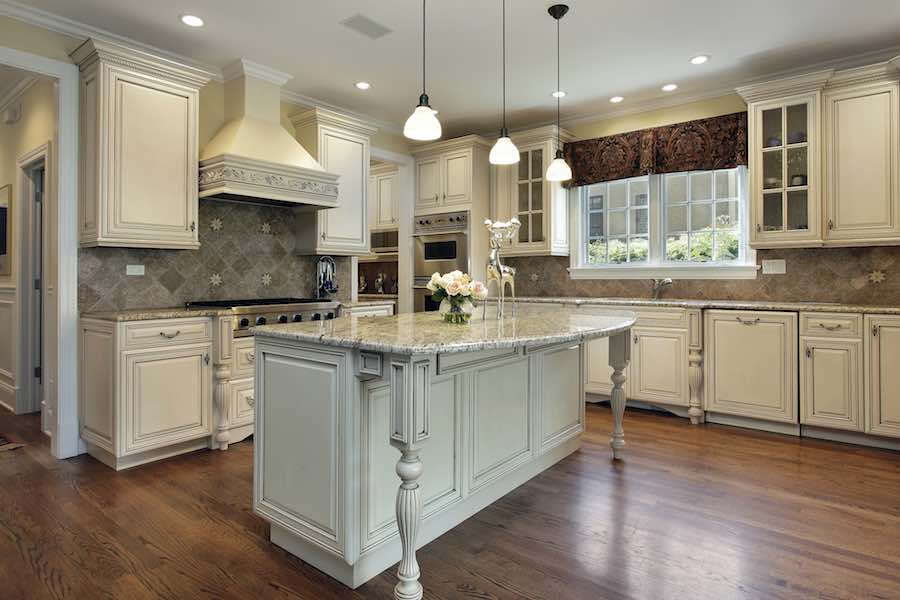
However, painting kitchen cabinets is not easy. It requires a lot of time and patience if you want the finished product to look great when you're finished!
In this post I'm going to show you not only how to paint your kitchen cabinets, but I'm going to share with you my 15 years of professional experience and how to make your painted cabinets look like they just came from a professional cabinet shop!
On top of this I have one secret that I use to make my cabinets look better than any other painter could and I am going to share this with you for the first time: The Flood Coat.
With the advice that I'll be going over in this article you'll learn the best ways to finish your cabinets, tricks to save time, how to get the absolute best finish possible whether you are spraying, rolling or brushing and how to have your kitchen cabinets look as though a seasoned professional did the work (only without having to pay them!).
At the end of this post I even created a Kitchen Cabinet Painting Timeline Infographic for you to reference and share!
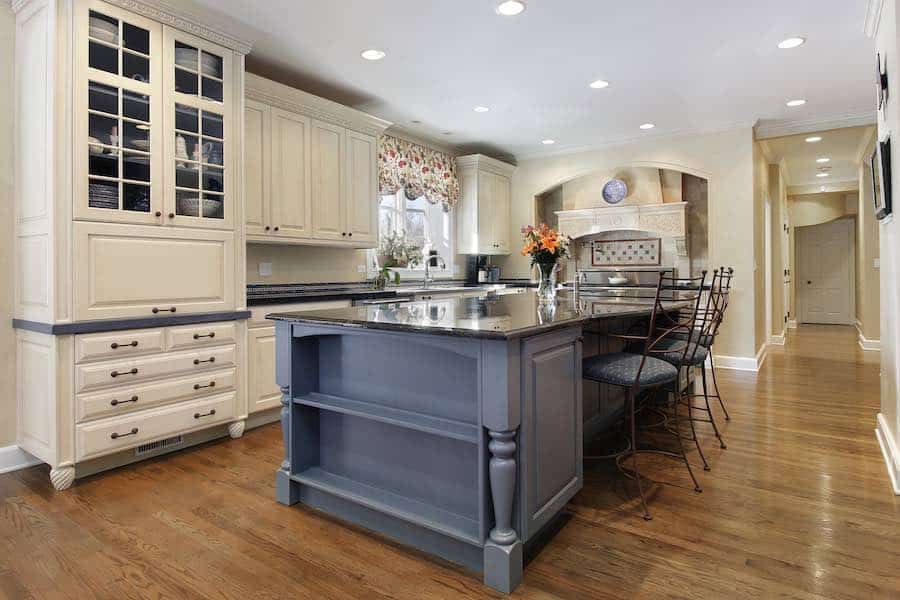
Kitchen Cabinet Painting Index
- Painting Terms Used
- How Much Does It Cost To Paint My Kitchen Cabinets
- Tools and Materials Needed For Painting Kitchen Cabinets
- What Type Of Paint To Use: Oil vs Latex vs oil/water Hybrids (and my favorite brands)
- Prepping Your Kitchen Cabinets
- Filling The Grain on your Cabinets
- Priming Your Kitchen Cabinets
- The Flood Coat
- How To Brush Your Kitchen Cabinets
- How To Roll Your Kitchen Cabinets
- Spraying Your Kitchen Cabinets for the Best Possible Finish
- Kitchen Cabinet Painting Timeline
Kitchen Cabinet Painting Terms
- Viscosity: This refers to the thickness of the paint. By adding a thinner (such as paint thinner or water) to a paint, you would decrease it's viscosity.
- Roller Nap: Roller nap is the raised threads/fabric on a roller. It refers to how far this fabric sticks out from the base (core) of the roller.
- Sheen: The luster or shine of the surface after it is painted. Different paints create different shines.
- Pigment: A substance that imparts color into a paint.
- Enamel: A hard protective coating. A paint that dries harder than average paint.
How Much Does It Cost To Paint Kitchen Cabinets
With so many variables, I am going to try to give you the most simple answer to this as possible and not leave it vague.
What would it cost to hire someone to paint your kitchen cabinets?
Painting contractors are going to vary quite a bit when giving you a quote to paint your cabinets. When I measure out a kitchen for a bid, I measure the fronts of all the cabinets (not the sides) and found that most kitchens ranged from 120 square feet (smaller end, but not a small kitchen) to 180 square feet (this would be a bigger, but not huge kitchen).
I would then charge $30 per square foot. So this would typically come out to equal $3,600 – $5,400 for your average nice kitchen. For this, I would refinish a kitchen in about a week, eliminate all wood grain and deliver exceptional quality (new cabinet shop level quality).
I often saw contractors relatively close to my numbers with an occasional painter charging a lot more or a lot less. Typically those charging a lot less did not know what they were doing and would leave the homeowner quite unhappy while the ones charging more couldn't actually produce a better product, they were typically just bigger companies.
So, for average's sake, assume that hiring someone to paint your kitchen cabinets is going to cost $4,000.
What Would It Cost To Paint Your Cabinets Yourself?
If you plan on doing this project yourself, you are going to save a lot of money. You should only have the cost of materials and maybe an HVLP sprayer if you want to get a really good finish.
When paying a contractor, labor is roughly 80% of your cost.
For materials, you're looking at 2 gallons top coat ($150), 1 gallon primer ($40), misc tape, sanding sponges, plastic, mixing cups, etc ($100).
Your total materials should be $300 – $500 depending on your kitchen size.
If you want to have the best quality possible, adding in an HVLP sprayer will add on an additional $100 – $1,000 (I'll elaborate on sprayers later on).
Two of my favorite HVLP sprayers are the Graco Finishpro HVLP 7.0 and the Titan Capspray 95 Turbine HVLP, but if you are on a budget, the Wagner Spraytech is drastically cheaper and still very nice!
If you do purchase a sprayer for your kitchen cabinet painting project, remember that you can easily sell it later on Facebook or Craigslist to recoup 50-75% of your cost.
There are some basic tools and materials you will need for painting your kitchen cabinets.
General Tools and Materials Needed
- Tape – For prepping off areas you don't want paint. Intertape, blue painters tape, and frog tape are all great choices with Frog Tape being the Cadillac of tape.
- 5-in-1 Painters Tool – A painter's tool is great for pressing tape, opening cans, cutting tape and more.
- Rags – You'll need lots of rags! These will be used for cleaning the cabinets, wiping off dust, cleaning spills, hands and much more.
- Sanding Sponges – You'll be using medium grit sanding sponges to sand the cabinets before you apply any paint and fine grit sanding sponges to sand after the primer coat and extra fine sanding sponges between top coats to ensure a smooth finish.
- Latex Gloves – Whether I am spraying or brush/rolling, I always wear a pair of latex gloves which makes cleanup far easier and saves my hands.
- Brown Rosin Paper – Rosin paper is for prepping off the floors and even the countertops. It is durable and last through an entire job. In my experience, you'll want the entire floor covered.
- Charcoal Face Maks – Even if you are using latex based paint and not oil, a charcoal mask is a good investment that keeps you safe and healthy.
- Paint Mixing Cups – I never use the paint straight out of the can. Typically I want to thin it down with either water or paint thinner. To get my mixes just right, a few mixing cups with measurements on the side is perfect.
- 1.5 – 3″ Paint Brush – Use a latex brush for latex paints and a white bristle for oil-based paints.
- Painter's Plastic – Painter's Plastic is used to block off the room, prep off countertops and more.
- Zip Wall Poles – Zip Wall Poles are optional but amazing for creating a barrier between your workspace and you home.
- Hand Masker Plastic & Tape Machine – The Hand Masker Plastic Machine used to quickly and efficiently tape off the insides of cabinet boxes and drawers.
- Masking Film – I recommend 48″ masking film for the insides of the cabinet boxes.
Extra Tools Needed For Brushing & Rolling Cabinets
- 4″ Paint Roller – I prefer a 4″ roller for cabinets as it gives you a good size surface while giving you plenty of control.
- 6 x 4″ Paint Roller Pads – Purdy 4″ roller covers with a 3/8″ nap are perfect for painting kitchen cabinets. Do not opt for cheap roller covers, they will shed all over in your finish and you will regret it.
- Small Roller Tray – Nice disposable trays for holding your paint.
Extra Tools Needed For Spraying Your Cabinets
- Painters Plastic – You'll need painter's plastic for prepping off the inside of cabinets, appliances and walling off the work area to prevent overspray from getting into areas where it is not wanted.
- HVLP Paint Sprayer – I will dive more into HVLP sprayers and why they are so fantastic later on in this article, but trust me, they are worth the money for cabinet and furniture finishing. Check out the Graco Finishpro, Titan Capspray or the Wagner Spraytech for three of my favorite sprayers.
- Full Face Charcoal Mask – A full-face respirator is a step up from the basic 3m respirator mask. It covers your mouth, nose, and eyes, which means it is protecting harmful vapors from entering your body through your eyes.
- Ear Plugs – If you are going to use a full face mask as I recommend above, earplugs are the next step. I wear earplugs to protect my brain, this is another area that harmful fumes can easily enter your body. Earplugs help protect your brain, I do not wear because of the sound of the sprayer.
- Paint Suit – A paint suit will keep you clean and free of overspray as well as protect your skin from absorbing the VOCs released by different paints.
What Type of Paint You Should Use On Your Kitchen Cabinets
There are two different topics I am going to cover when talking about types of paint. The first is going to be oil vs latex paint and the second is the actual brands and products that I use and recommend.
Just to get this out of the way, when you see me or any brand referring to an enamel, an enamel is simply a paint that dries to a smooth hard coat (much harder than standard paint). So cabinets, trim, doors, and furniture will typically use an enamel.
Oil vs Latex
Oil Based Cabinet Paint
According to Wikipedia, an oil paint is a slow drying paint that consists of color pigments suspended in an oil (typically linseed) and thinned (viscosity raised) with a thinning agent such as mineral spirits.
Oil paints are desirable for their durability and lustrous look when finished. The slow drying aspect of these paints also makes them easier to get a glassy smooth finish because it allows more time for the paint to settle to a uniform finish.
Oil paints also have their cons though. They typically have a much higher VOC content than their water-based counterparts. This can be overcome by wearing a charcoal filtered mask and properly venting your painting area, but will still leave your house smelling rough for 1-2 weeks.
Other cons are that oil paints are harder to clean up and require mineral spirits to clean brushes, sprayers and other tools. The used mineral spirits and leftover oil paint must also be properly disposed of legally and also contain high levels of VOCs.
Water Based Cabinet Paint
In the beginning, all paints were oil based. Sherwin Williams actually developed the first water-based paint in 1941.
With the push for greener and healthier products, water-based paints have come a long way and are now almost equal or better in many areas of painting.
Water-based (latex) cabinet paints are faster drying paints that consist of pigments suspended in acrylic latex. The thinning agent for these paints is water.
Water-based enamels have an almost similar durability to oil-based paints and also have a great finished look.
One drawback is that due to their faster drying times, it can be harder to get a lustrously smooth finish similar to oil.
The benefits of water-based finishes are many though.
The first benefit of water-based paints is that cleanup is incredibly easy. Just bring your tools to your wash sink and use warm water and some soap.
Second, they typically have far fewer VOCs making them safer and better for the environment.
Third, there is no difficult disposal. Leftover paint is easy to dry out and throw in the garbage.
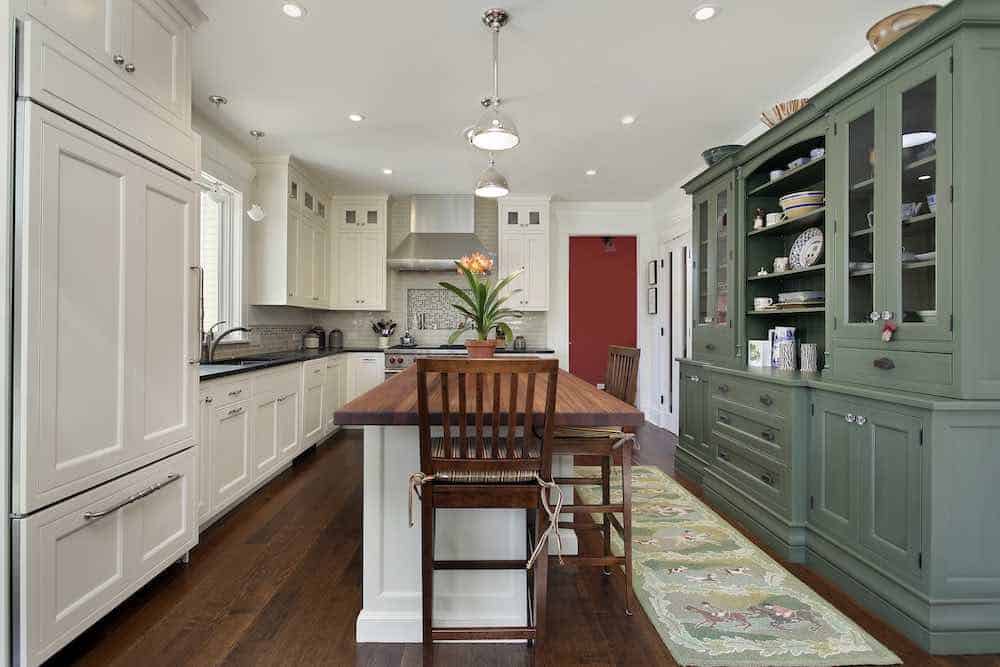
Hybrid Acrylic Alkyd Cabinet Paint
In the last 10 years, the painting industry has been working hard on making hybrid paints that provide the low VOC content and easy cleanup of water-based paints with the durability and lustrous finished look of oils.
These hybrid paints are called Acrylic Alkyd paints and in my opinion, they are fantastic.
I have used Sherwin Williams hybrids and they really do give the look and durability of their oil based finishes while saving me time and money with the easy cleanup of water, not to mention the low VOCs that both I and homeowners love.
Technically these paints contain an oil molecule that is encapsulated in water. So as the water evaporates, it leaves behind a finished oil product.
What I Recommend
I used to recommend oil-based finishes. They looked better and were more durable.
But these days I have changed my mind. I am not open to headaches oil paints cause or exposing my family and clients to high VOCs.
And with the introduction of Hybrid paints, the choice is easy.
Hybrid paints are fantastic. My two favorite products for hybrid paints are Sherwin Williams Pro-Classic Acrylic Alkyd and Benjamin Moore's Advance. Both are fantastic.
My second choice is to go with a water-based enamel. These enamels really do look fantastic and I would argue that 90% of people couldn't tell the difference.
in today's world, I don't see a need to use an oil based product anymore. They are outdated and unnecessary. Therefore, I will not be referring to them in any of the following instructions.
Brands I Recommend
As you can tell from the above paragraphs, I obviously recommend Sherwin Williams. They are definitely more expensive than many other paint stores, but their products are top notch and their employees are super helpful.
The other brand I really like and recommend for homeowners is Benjamin Moore. They have two different products that I love, Satin Impervo (for water-based and oil-based finishes) and Advance which is their hybrid Acrylic Alkyd. I have used both on many different projects and love both products. They are durable, easy to apply and look great.
While I do like Behr products, I do not currently recommend any of their paints for kitchen cabinet finishing.
Prepping Your Kitchen For Cabinet Painting
Painting your kitchen cabinets is a job that is 80% prep work and 20% actual painting. You'll find that if you do your prep work properly by taking your time and paying attention to detail, your actual painting time will be shorter and your final product will look amazing.
Clean Out Your Kitchen
The first thing I do in any painting project is to clean out the area entirely.
Every cabinet, countertop, and drawer needs to be emptied until nothing is left in the kitchen. Consider this a great time to reorganize your kitchen after the project is completed.
Remove The Door and Drawer Handles
The next thing to do is remove all the door and drawer handles. Make sure to grab a bag or container and place every handle and screw in it and place it in a safe place until the project is completed.
Remove All Doors, Drawers, and Hinges
After the handles are removed, it's time to remove the doors, drawers, and hinges.
Pro Tip: One of the best things you can do, that you will definitely thank yourself for later, is to label everything during this step.
I like to take a roll of masking tape and use it to label where every door went. I take a small piece of tape and write "#1" on it and place it on the back wall inside the cabinet. Then when I remove the door and hinges, I write "#1" right on the door under where the hinge was. Since the hinge goes over this area, you will never see it. Then I place a small piece of tape over my writing so that when I paint the door, I don't paint over my label.
I do roughly the same on drawers. I write "D1" for "Drawer 1" and place it on the wall inside the cavity where the drawer was, then on the bottom or back of the drawer, I write another "D1". This doesn't usually need tape to cover it as I don't paint the bottoms or backs of drawers.
Hinges shouldn't need to be labeled, but if you feel like labeling them to match their existing locations, it should only help.
Clean All Surfaces
Now it's time to clean everything. I'm not yet referring to the wood that you are planning on painting, I'm talking about inside the cabinets, the floors, and the countertops.
Dirty floors and countertops don't hold tape well. Shop vac everything and wipe down all hard surfaces.
Tape & Cover Floors
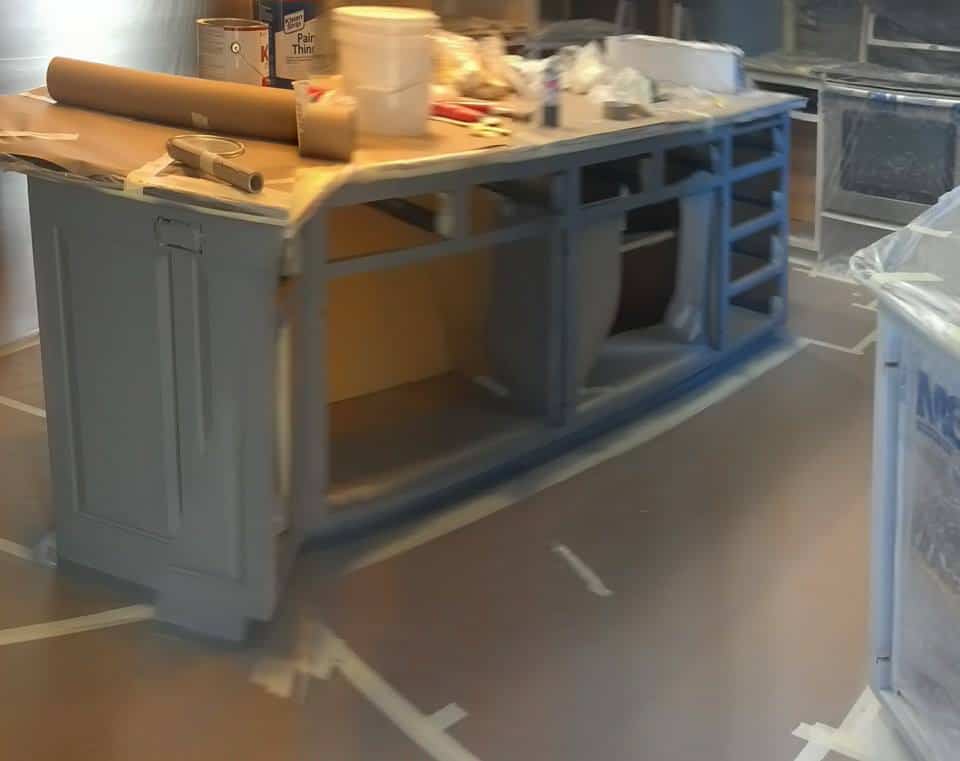
Next, run a line of tape around the outside of the room along the cabinets where the quarter round (trim) meets the floor. I typically like to do two layers of tape around the outside of the room and around any center islands.
This gives me a little bit of room to lay down and tape the brown rosin paper that I use to cover the floors in the kitchen while painting.
I personally do not recommend using drop cloths when painting kitchen cabinets. The reason for this is drop cloths move and get drug around. You almost always will end up with paint on the floor in the end.
Brown rosin paper gets taped in places and shouldn't move all until your job is complete. This along with the fact that paint can seep through drop cloths easier than rosin paper makes brown rosin paper my go-to choice for covering floors during kitchen cabinet painting projects.
Tape & Cover Countertops
All of your countertops should be covered in plastic as well. Personally, I like to place a layer of brown rosin over the countertop and then another layer of plastic over this. This double protection comes in handy if you have any large spills on the countertops (I like to set things on the countertops while I'm working, so paper + plastic keeps me and the countertop safe!).
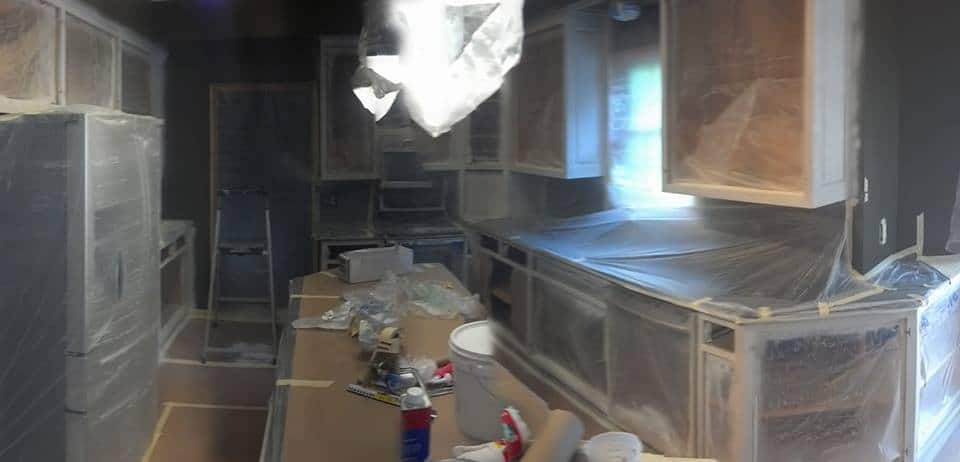
Plastic Off The Insides of Cabinets
Using plastic and covering off the insides of the cabinets will help you if you plan on spraying your kitchen cabinets with an airless sprayer or an HVLP sprayer.
If you plan on brushing your cabinets, this step can easily be skipped with little to no consequences since this step is mainly to prevent overspray from going inside your cabinets.
I like to use a 3M Hand Masker to run a line of tape and painter's plastic right behind the inside edge of the cabinet face frame.
I then run a line of tape around the other three inside edges.
Finally, pull the plastic and connect it to the three other strips that you ran around the inside of the face frame to create a plastic wall blocking overspray from the getting inside the cabinet.
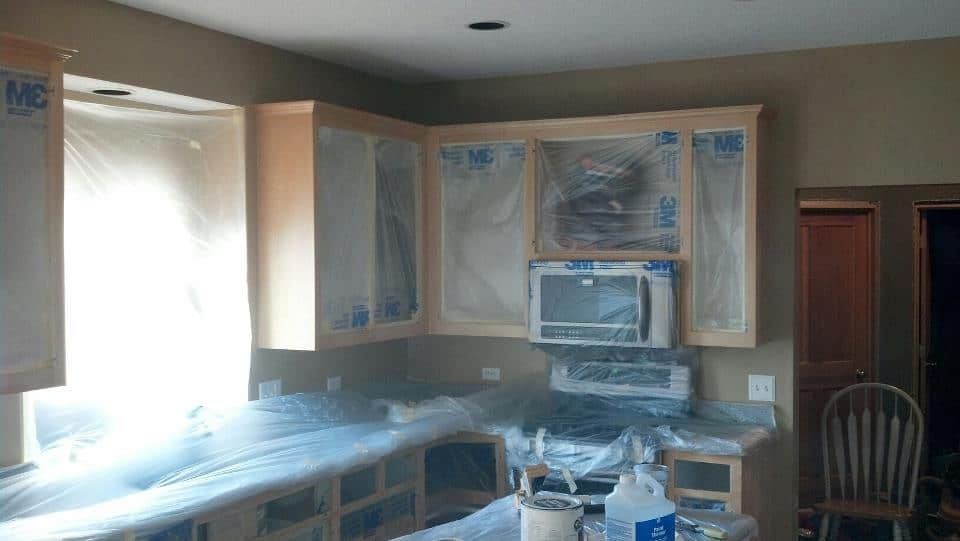
Create A Barrier Between Your Workspace And Your Living Space
If you plan on brushing and rolling your kitchen cabinets, you can again skip this step, but if you plan on spraying, this step is an absolute must.
The last step to get your kitchen completely ready to start painting is to create a barrier between the area you will be working and any attached living spaces.
With today's open floor plans, this usually means making a large plastic wall to keep any overspray from getting out of your work area and into your living area.
I like to use Zip Wall Poles. Zip Wall poles are spring loaded extending poles that you attach painters plastic to the top, then extend them to the ceiling. Then you take the bottom of the painters plastic and tuck it under the bottom of the Zip Poles. In roughly 5-10 minutes you have a sturdy plastic wall barrier between your workspace and your non-workspace.
Create A Separate Workspace In Your Garage or Basement
An extra step that will save you a lot of headaches is to create a separate workspace where you can work on your doors and drawers outside of your kitchen.
If you have an extra garage stall or an unfinished basement, using this area for a few days will be extremely convenient compared to trying to paint your cabinet doors and drawers in the kitchen where you will have little to no extra space.
Set up this workspace just like you did your kitchen. Prep off the floors with brown rosin, create plastic walls (ideally using Zip Wall poles) and put in a couple of saw horses to place your doors on while you paint them.
Prepping The Kitchen Cabinets For Painting
Now that your kitchen is all prepped, it's time to start prepping the actual cabinets and get them ready for paint. Like I said earlier, kitchen cabinet painting is 80% prep work and 20% painting. Be patient, take your time and your cabinets will turn out great!
Wash All The Wood That Is To Be Painted
Kitchens have a tendency to have grease build up over time on everything. The walls, ceilings, and your cabinets. This grease is detrimental to painting and if you try to sand it off, your sanding sponge will gum up and get ruined very fast.
To remove this grease, mix up a bucket of hot water and a little bit of dish soap and scrub down every square inch of your kitchen cabinets that are going to get paint.
A clean wet rag as a rinse should work just fine to get any soap residue off.
Sand and Vacuum All Wood
Now that the grease and grime has been removed, you need to sand scuff all of your cabinet boxes, door, and drawers.
For this step, you'll be using 3M Medium Grit Sanding Sponges.
You really want to break down the current surface which is likely a smooth previously painted surface or a clear smooth finish on wood.
This will break that finish down and allow your primer to properly bond to your kitchen cabinets.
NOTE: This one little step can easily be the difference between paint that chips off in 1-5 years or paint that lasts 10+ years.
When you are done sanding everything, shop vac every last bit of your kitchen and your cabinets.
Fill The Grain In Your Kitchen Cabinets
This step is completely optional, is typically only done on oak cabinets since oak grain runs very deep in the wood and is done purely for cosmetic reasons. This step adds a lot of extra time, but can drastically improve the look of painted oak cabinets.
If you have existing oak cabinets, then filling the oak grain may be a step that you should really consider if you want the best finished look possible.
Filling the grain will help reduce the amount of grain that shows through to your final product and make the cabinets appear smoother. This will not 100% eliminate the grain that shows through to the final product, but it will greatly reduce it.
I have tried many different grain filling methods over the years and I developed this method for its speed and effectiveness.
Take a mixing bucket and put two cups of Joint Compound (yes regular old drywall mud) and one cup water and mix them up until the consistency is a thick soup (or a really thick paint). Double or triple the amounts if you have a bigger kitchen.
Now take an old paintbrush and brush the joint compound mixture onto all of your cabinet boxes, doors, and drawers. Make sure to really work the compound into the wood grains by brushing over it multiple times with pressure. Do not leave an excess of compound on the cabinets as this will just make more work to sand it off later.
Once the joint compound has dried on your cabinets (typically an hour or so), take a 3M FINE grit sanding sponge and sand off all excess joint compound (do not use medium grit). When you are done, you should only see fine streaks of white joint compound in the oak grain.
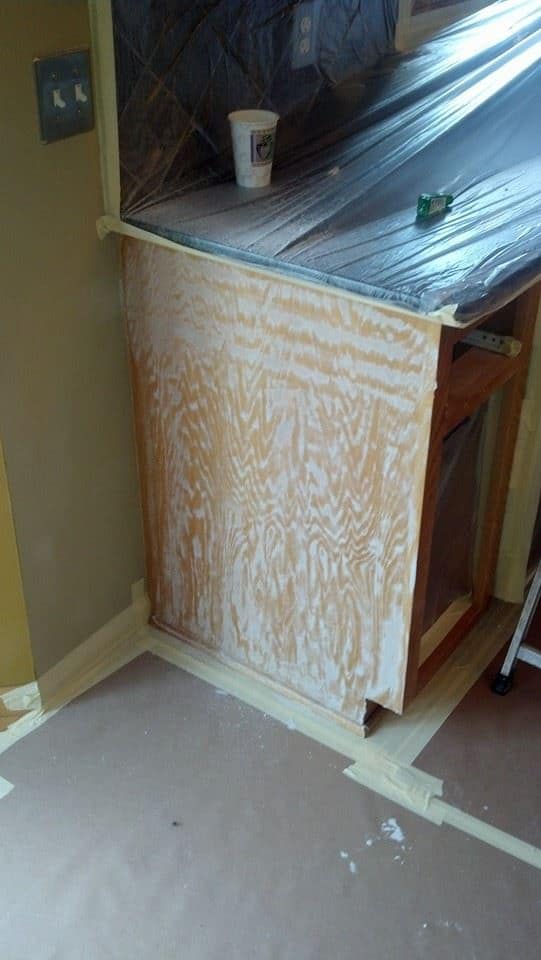
The reason I use joint compound is that it is easy to sand, cheap to buy, and easy to apply. It also bonds nicely to the wood and will not fail out once painted over.
When completed, shop vac everything. (it will be VERY dusty)
Repair Any Damage In Doors or Cabinet Boxes
Now is the time to do any repairs in your cabinet boxes or doors if you need to.
Patch any large dog scratches, dings or gouges with the same joint compound that you used to fill the grain. Simply use a standard 6″ mud knife and fill the area, allow it to dry and re-fill it again if you have any shrinkage. Then sand smooth.
If you plan on using new hinges or handles when your cabinet painting project is completed, now is also the time to fill the old holes.
Since you may need to drill new holes in very close proximity to the old holes, use a harder drying wood filler to fill any old hinge or handle holes. Wood filler will dry harder and you can drill it and screw new hinges into it. Please be aware that wood filler also sands much harder, so be prepared for some extra sanding.
Caulk All Gaps and Cracks
Next, it's time to caulk the gaps between cabinet boxes, crown molding, and base trim.
These areas are all caulked rather than spackled because caulk is flexible and allows for movement between two pieces of wood without forming new cracks. Spackling paste is not flexible and will crack as the different pieces of wood expand and contract at different paces.
Make sure to take your time and use a dripless caulk gun to have a better smoother caulk bead. After every bead of caulk you lay, take a wet cloth and wipe the caulk smooth.
Caulking your gaps and cracks will improve the final appearance by eliminating shadows and gaps that show as dark contrasting lines in the finished product.
Vacuum Everything
A dust free environment equals a great looking, smooth finished product.
Priming & Top Coating Your Kitchen Cabinets
Now that your kitchen is prepped and all your kitchen cabinet boxes, doors, and drawers are prepped and ready for paint, it's time to start priming and top coating!
Now is the time that you are going to have to decide if you are brushing or spraying your cabinets.
There are no real special tricks to applying your primer or top coat with a brush other than making sure to keep your brush strokes in the same direction and have smooth starting and stopping points.
Special Painters Trick For Flawlessly Smooth Cabinets – The FLOOD Coat
This is a trick I developed after painting oak cabinets for years and trying to find ways to give a smoother and smoother finish when painting oak.
Since oak has deep wavey grain, it can be incredibly hard if not even impossible to completely remove the grain look.
The flood coat, as I call it, is painting on your primer coat incredibly thick and thus filling in the last of the grain that the grain filler did not fill in or cover up. This can be done in two ways and can only be done on your doors and drawers if you lay them flat on a saw horse for painting.
First, If you are spraying, slow down your spraying and spray on 2 times the amount of primer that you normally would. Because the doors are flat, they will not run. Repeat this and apply a second coat of thick primer once the first coat has dried.
If you are brushing, brush on 2-4 coats of primer rather than trying to do it all in one coat.
Make sure to let your primer dry 100%.

You will likely still see the waviness of the oak grain at this point. But since your primer is so thick, we can sand this waviness out and get your oak cabinet doors 100% flat and smooth.
Next, take out a random orbital sander with a 150-220 grit sanding disc. Start sanding down the flat areas of your doors and drawers until they are perfectly smooth and flat.
Make sure not to over-sand and sand through the primer exposing the oak (you'd have to start over!). Since your primer is so thick, you shouldn't have any trouble not sanding through to the oak.
This method has worked so well for me that you could hold 30-year-old oak doors that I painted up to brand new cabinet doors from the cabinet shop and not be able to tell the difference.
Note: You will not be able to run your random orbital sander in the grooves of raised panel doors, so you will have to do a bit of hand sanding. You will however still be able to power sand 90% of your doors.
How To Brush Your Kitchen Cabinets To A Beautiful Finish
The key to brushing your kitchen cabinets to a beautiful finish is not necessarily in how you brush or roll on your paint, but the work you do in between coats.
After your primer coat, you are going to want to sand everything with 3M Fine Grit Sanding Sponges. This will smooth down the primer coat and allow the top coat to bond even better.
When brushing on your top coat, at a minimum you are going to need two coats, but to be on the safe side, expect three coats.
In between every top coat, you should lightly sand down the previous coat with 3M's Extra Fine Grit sanding sponges. These sponges will knock down any dust and smooth out brush strokes while scuffing the surface for the next coat. Do not use fine or medium grit sponges as the scratches will be too deep and could show through to the final coat.
Pro Tip: When I brush out cabinet doors, patience is key. I like to brush one side of every door while they are laying flat. After this dries, I flip them over and brush the back side. Once that has dried, I will sand and vacuum both sides, then start over by brushing the front side. Repeat this process typically for 3 coats or until everything looks great and the color is solid and smooth.
The Brushing Technique
When you brush, make sure all of your strokes are smooth, even and in the same direction. Be light with your strokes to not leave big marks where you start and stop.
Want to learn even more about brushes, check out my complete guide on paint brushes and how to clean paint brushes.
How To Roll Your Kitchen Cabinets
I typically don't recommend rolling your kitchen cabinets and the only type of cabinet where it is even possible is cabinets with completely flat doors. No grooves, trim or anything, just flat doors.
If you do choose to roll your kitchen cabinets, I recommend using a 4″ roller with a Purdy 3/8″ White Dove pad cover. The 4″ roller gives much more control than a 9″ roller would while the White Dove cover leaves a very light stipple that will be barely noticeable while not shedding fuzz into your finish.
Stipple is left by all rollers when the rolling pad pulls away from the surface you are painting. This is great when you are painting walls (as it leaves a very subtle but nice texture on the walls), but on kitchen cabinets, it can be an undesirable look. Most people prefer the look of smooth sprayed cabinets.
To get your rolled cabinets to look as smooth as possible, make sure to thoroughly sand and vacuum between every coat.
To get the smoothest finish possible, roll on at least two coats of primer (three is even better). This will give you a thick layer of primer that you can sand to a perfectly smooth finish with a random orbital sander and a fine grit paper (like 150 or 220 grit).
Then after you have rolled on your first coat of top coat, take the extra time to sand it as smooth as possible with an extra fine sanding sponge.
This extra work will mean that the only stipple to show through to the final coat will be the stipple left over from your final coat and not the buildup of multiple coats.
How To Spray Your Kitchen Cabinets (The Best Finish Possible)
There's no way around it, spraying your kitchen cabinets is far and away the best possible way to give your cabinets the smoothest, most even and beautiful coat possible.
On the downside, sprayers do cost a bit of money and the nice ones can cost a lot of money. Spraying is also a skill that can take a bit of time to become comfortable with.
However, I believe that with a little bit of patience and a few guidelines, almost anyone can achieve success with spraying their kitchen cabinets.
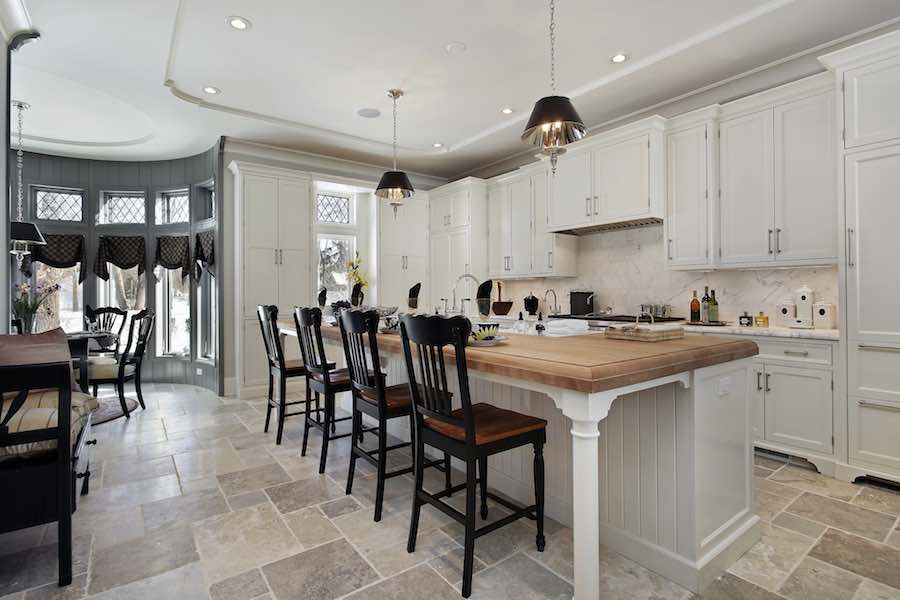
Setting Up Your Sprayer & Spray Area
Obviously, if you are spraying you are going to need to do some more prep work than if you are brushing and rolling your cabinets. This is due to the over-spray the will be created. Don't worry though, you will save far more time from spraying than the extra time you spend prepping your spray area!
Typically, this means that you must wall off all areas that are not going to be painted (like I discussed earlier) and cover every countertop, window, appliance, floor, inside of cabinets and anything else you don't want paint on with paper, plastic and tape.
You're also going to want to set up an area in a separate space such as an unfinished basement, garage or shop where you can take the cabinet doors and drawers.
I like to wall off a 10'x10′ space with plastic (to contain the overspray), cover the floor with rosin paper and place in 3 – 6′ folding tables to work on. Then I use the tables for spraying the cabinet doors and drawers (I will cover this more in the next section).
Air Sprayers & HVLP Sprayers
There are two main types of sprayers on the market, air sprayers, and airless sprayers.
Airless sprayers are sprayers that use a piston to build up pressure inside the pump and then force the paint through a small spray tip, thus producing a spray fan. These pumps are typically best for larger production, commercial or exterior painting projects.
There are small tips that you can buy that do give airless sprayers the ability to spray a small, even pattern that can work for painting kitchen cabinets, but I would not recommend this method. It takes a lot of skill to achieve a nice finish, is incredibly easy to get runs and creates a lot of overspray.
My preferred type of sprayer for painting kitchen cabinets is an HVLP Air Sprayer. Air sprayers come in two types, HVLP and regular. HVLP stands for High Volume Low Pressure and allows your air sprayer to spray out high volumes of paint at incredibly low pressures (meaning easier to controll and get a better looking finish).
At its core, the main difference between an airless sprayer and an HVLP sprayer is this:
Airless sprayers typically spray out paint at a pressure of 1,500 – 2,500 psi (pounds per square inch) while an HVLP sprayer sprays out paint at a pressure of 7 – 13 psi.
This isn't referring to how much paint is coming out, just how hard the paint is coming out. Paint coming out at 2000 psi is going to be hard to control, create a lot of overspray and create a lot of waste. Paint coming out at 10 psi, is going to adhere to the surface better, have less overspray and be easier to control.
The best example to illustrate the difference is this: Airless sprayers have a 50-70% transfer rate, meaning 50-70% of your paint will end up on your intended surface. HVLP sprayers have a 90-98% transfer rate, meaning little to no overspray!
HVLP sprayers are actually what cabinet shops and auto body shops use to achieve their incredible looking finishing and what I used for refinishing and painting kitchen cabinets for the past 15 years.
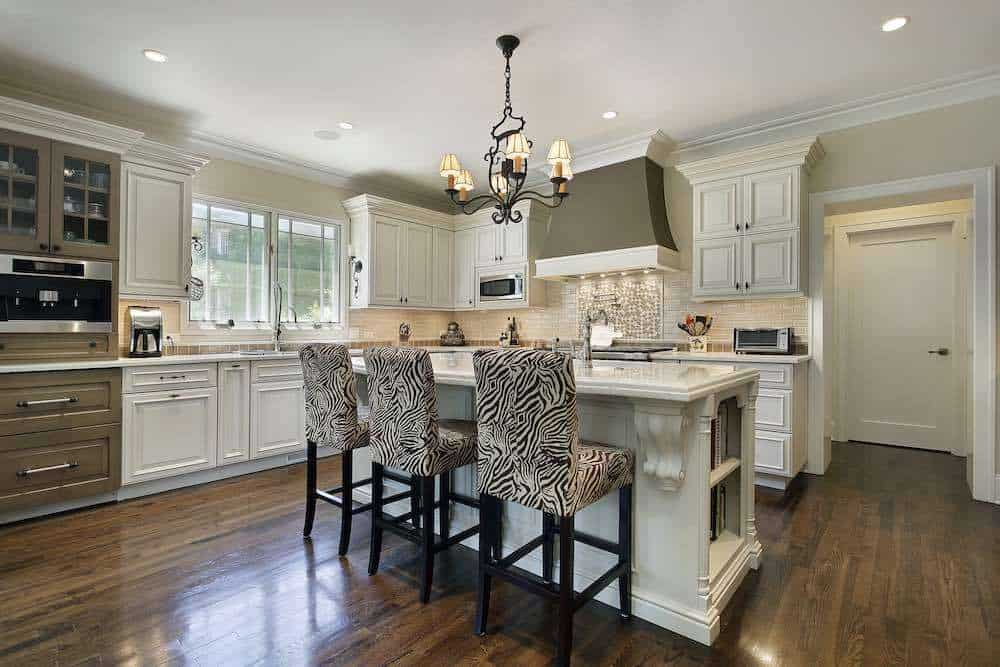
You can actually purchase a great HVLP paint sprayer by Wagner for right around $100 here. Of course, if you are looking for a top quality HVLP, you can check out my personal favorite the Titan Capspray 105. The Titan is more of a high-end sprayer, so if you plan on only using your sprayer once,
Getting The Best Results With Your Sprayer
#1: Practice Spraying On Cardboard
Brown cardboard boxes are great to practice your spraying on. This will allow you to fine-tune your strokes, spray fan and overlap until they are perfect before moving on to your cabinets.
Another way to get more practice is to spray all the back sides of your cabinet doors before spraying the fronts. If the backs don't look 100%, that's fine!
#2: Spray Your Doors and Drawers While They Are Laying Flat (horizontally)
This tip will slow down your project, but will greatly increase your odds for success.
Runs can form on your cabinet doors if you spray too heavily and they are hanging verticle when you spray them. Runs are a huge pain in the butt and are hard to sand out without sanding through the finish, the primer and all the way to be wood, causing you to start over on the door.
On the other hand, spraying your cabinet doors too light can cause rough doors and poor coverage.
By laying your doors and drawers flat (on the 6′ folding table I talked about earlier), you are able to spray on nice thick coats of finishing without the fear of having runs in your finish.
It also allows the paint to settle more evenly and thus produce an even better finish. This is by far the easiest way for a beginner to achieve a great looking sprayed finish.
Obviously, this will not work when spraying your box frames that are not removable from your kitchen. You are going to have to spray these vertically. To achieve a great looking finish on your box frames, it is best to spray lighter coats and to spray more of them (typically 1-2 extra coats). Just take your time and try not to spray so much where runs start to form.
#3: Overlap each stroke with the sprayer by 50%
Having proper overlap is important when spraying your cabinets. The goal is to aim for a 50% overlap on every pass of the sprayer.
This will create an even and consistent finish coat on your cabinets.
#4: Always clean out your sprayer immediately after use
Never allow paint to dry in your paint sprayer, this will create a cleaning nightmare!
If you have listened to me and purchased either a water-based enamel or a hybrid enamel, all you need to do to clean your sprayer is to run warm water through the sprayer until it sprays out completely clear. Then gently wash off any paint on the outside of your gun or sprayer and you should be good.
#5: Cover up when spraying to protect yourself and for easier cleanup
When I spray kitchen cabinets I always wear a paint suit, latex gloves, a full charcoal face mask, and ear plugs.
In all honestly, water-based finishes do wash off easily and spraying 1 kitchen is not going to do any long-term damage to your body. But for me, spraying as often as I do, I like to protect myself and make cleanup as easy as possible.
A paint suit protects my clothes and keeps me from having to look like a slob before and after work. Latex gloves keep my hands clean. A full face mask protects my lungs and eyes from overspray and VOCs. Earplugs protect my brain from absorbing VOCs released into the air.
Of all these things, #1 is to wear a charcoal 3M mask. Breathing in the VOCs released by the paint is bad for your health and even worse is breathing in tiny latex particles in the air from your sprayers overspray. These will build up in your lungs over the years and can cause long-term damage.
Final Thoughts on Spraying Your Kitchen Cabinets
Sprayers are great, they allow you to work faster and achieve a finish free from brush strokes and roller stipple.
I'm currently working on a huge guide to airless and HVLP sprayers where I will go far more in-depth on each type of sprayer and how to get the most out of both. Make sure to check back for it soon!
Kitchen Cabinet Painting Timeline
Two of the questions I get asked more than anything is how long the process of kitchen cabinet painting takes and what is the timeline of the different steps.
Curious how long it takes to paint a room? I've covered that as well, you can find the answer here.
So I decided to finish off this post with a nice infographic detailing the timeline of kitchen cabinet painting. Feel free to print this graphic, share it or save it!
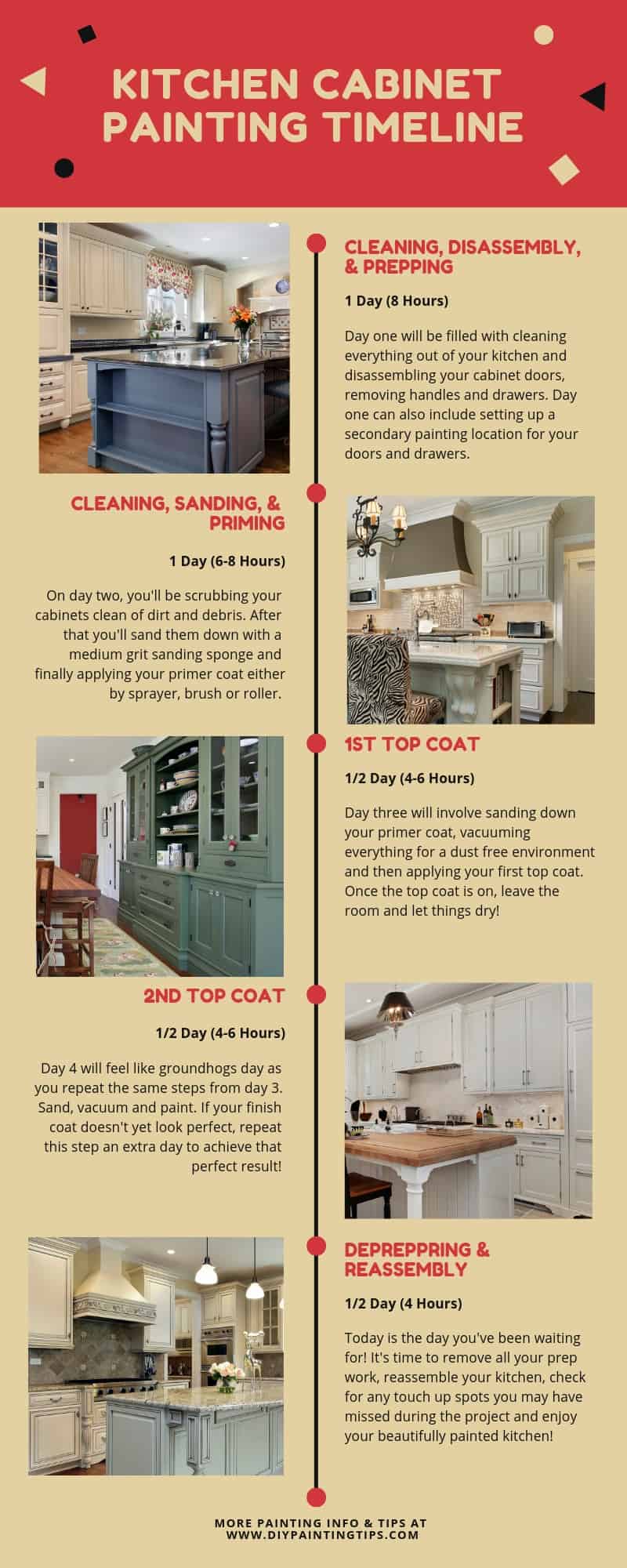
Hopefully, this post has given you the confidence to tackle painting your own kitchen cabinets. Remember to follow the advice I have given here, take your time and you will achieve incredible results while saving a lot of money!
If you have any questions about your project or if you used this advice to complete your own project, please leave a comment below, I'd love to hear from you!
How to Paint Kitchen Cabinets Diy
Source: https://diypaintingtips.com/how-to-paint-kitchen-cabinets/
0 Response to "How to Paint Kitchen Cabinets Diy"
Post a Comment